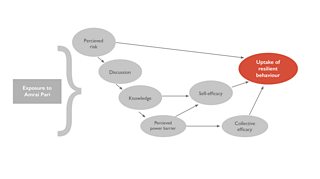How can media help people in Bangladesh prepare for disasters?
Aniqa Hossain
Research Officer, �������� Media Action Bangladesh
In Bangladesh, we’re pretty disaster-prone. Cyclones are a regular occurrence and much of our coastline is low-lying and often floods. This is a fact of life for many people, and they have little option but to find a way to survive. However, the lack of infrastructure can be too overwhelming and make it hard for people to know where to start.
As communicators, there is a lot we can do to help people become more resilient, so that they can take steps to prepare in advance and mobilise resources in the aftermath of a natural disaster. But we have found that communication is most effective when you don’t just tell people what to do but how to do it.
To help our teams make useful and effective resilience programmes, we needed to identify – and understand - the factors (or drivers) that affect whether or not people will take action to prepare for disaster. Initial research showed that the two main drivers were ‘working together with others in their community’ and increasing awareness that people could prepare for extreme weather themselves without waiting for government help.
Using this work, our resilience programme visited communities around the country and demonstrated some simple techniques people could adopt using locally-available materials, such as home improvements and storing food or water. It helped and encouraged communities to work together to improve their economic wellbeing and prepare for extreme weather events.
To evaluate the programme, we wanted to know not just what impact watching the programme was having on viewers but also know how this impact was happening. To do this we tested our theoretical model of how we thought change was going to happen (using a statistical technique called ) against data we had collected during surveys and measured the relationship between them. Other teams in �������� Media Action had used structural equation modelling when so we knew it could help us understand what drives people to make changes.
How did we come up with our theoretical model?
Based on previous research, and brainstorming with the team, we came up with this model (the arrows show the ways in which we believe one factor influences another). In summary, we thought that the higher an individual’s risk perception, the more motivated they are to act.

Diagram 1: Our first attempt at modelling the factors that led to ‘resilient’ action
Before we broadcast the programme, we asked 3,500 Bangladeshis a series of questions to understand how they perceived specific issues related to flooding and natural disasters -including knowledge of seasonal weather patterns, discussions around disaster preparedness, attitudes towards taking actions and their perception of financial barriers.
For example, we asked participants to mark their risk perception on a scale of 0-10, where 0 would mean no risk and 10 would mean the highest risk, for the natural disaster that frequently occurs in their areas such as flood, river erosion, cyclone, drought etc.
We used this survey data to test the model. We also tested this model for particular ‘target groups’ – people living in the North-West; South- West and in cities with more than one million people. This testing showed two things:
Firstly, that power structures or the decision-making process of a community, play an important role in people’s intention to act. But the power structures and their influence on a community looked very different in urban and rural areas. For example, when any natural disaster occurs in a rural region, people go about solving their problem collectively whilst in urban slums we saw that people took decisions by following a leader of their community. These findings were backed up by our observations during fieldwork in rural areas.
Secondly, we realised in the course of analysing the data that our original model was too complicated, and we needed to have another go! After several iterations we agreed on a final model that was used to test the effectiveness of Amrai Pari itself using conducted after the programme was broadcast.
How effective was Amrai Pari at instilling resilient behaviours?
After Amrai Pari stopped broadcasting we wanted to investigate how it had influenced those key drivers, and simplified our model.

Diagram 2: The simplified model during the post exposure evaluation
We found that people who regularly watched Amrai Pari were more likely to have a keener perception of the risks of natural disasters than those who did not. The makers of Amrai Pari tried to boost viewers’ perception of the risks they potentially faced by featuring “relatable” Bangladeshis who had also suffered as a result of a weather-related disaster.
Also, viewers were more likely to feel confident to work with other community members and needed less external support from NGOs or the government. Our statistical analysis showed that this was associated with increased self-efficacy and collective efficacy – both of which are associated with people’s likelihood of taking action. These findings are important because, at least in theory, these viewers are also more likely to take action.
Although developing this model was initially challenging - in part because there had never been another study conducted that had tested these specific concerns - our refined model enabled us to understand and can now be used by other researchers to improve the theory of resilience. More fundamentally, the process of this analysis enabled us to understand better what helps and what stops people to act against natural disasters and extreme weather events.
In addition to that nearly half (47%) of all audience members reported that they took action to deal with shocks and stresses after being exposed to our programme. We believe our constant collaboration between research and project teams helped us achieve this impressive result.
